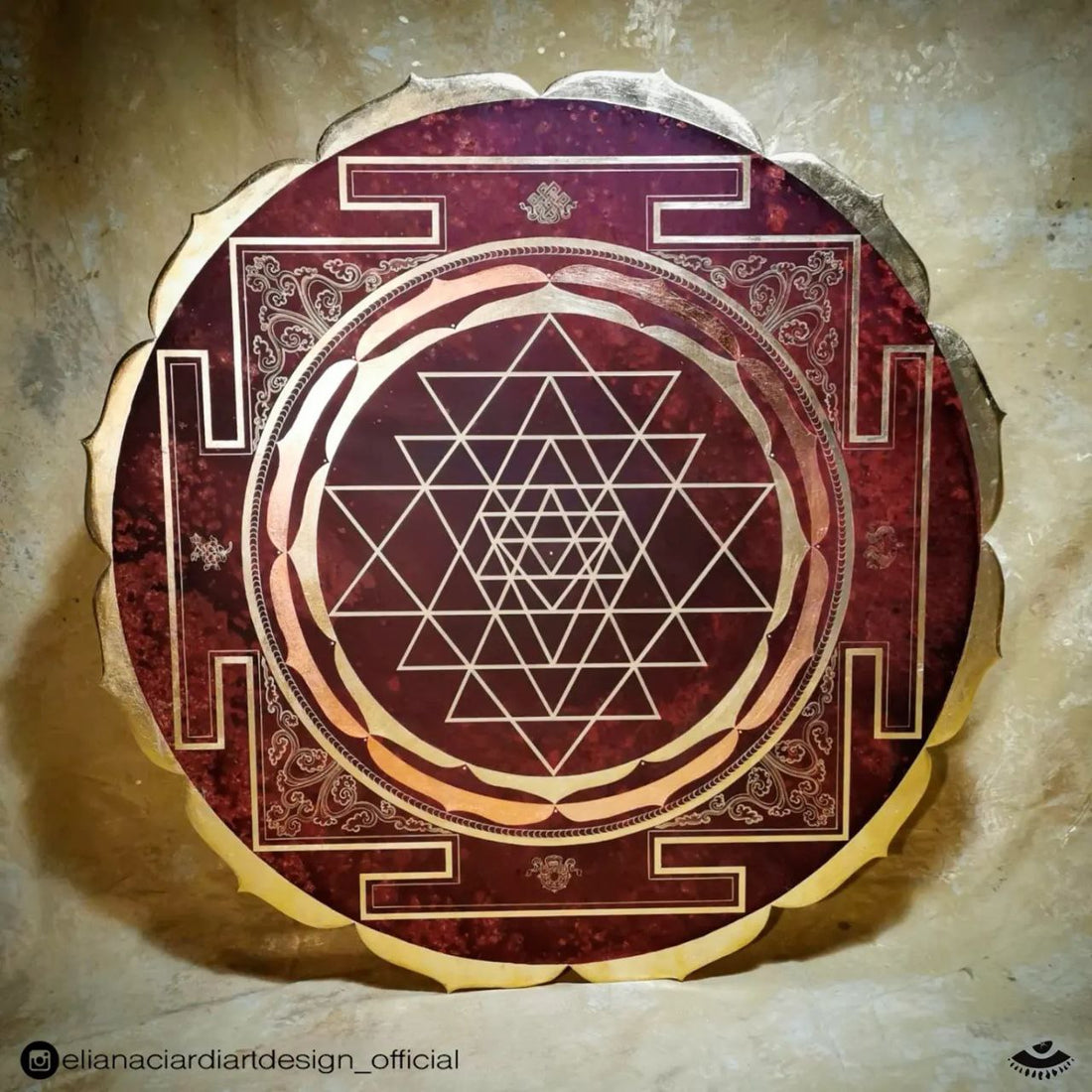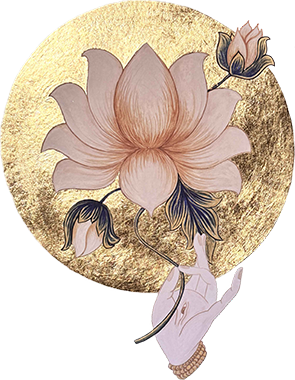
The Spiritual Meaning of the Sri Yantra: A Portal of Transformation
The Sri Yantra is one of the oldest and most powerful symbols of humanity. Originating from the Hindu tantric tradition, this sacred mandala has been studied for centuries by mystics, mathematicians, and scientists alike. Its intricate geometric structure not only represents the union of the masculine and feminine principles of the universe but also a visible manifestation of the energetic and vibrational laws that sustain all existence.
In recent years, the Sri Yantra has drawn the attention of researchers worldwide, particularly in studies conducted at Moscow State University, where scientists analyzed its structure and energetic effects using modern physics tools. The result: a bridge between science and spirituality demonstrating that ancient sages understood universal truths about vibration, consciousness, and form.
The Sri Yantra: Architecture of the Cosmos
The Sri Yantra is composed of nine interlocking triangles: four pointing upwards (symbolizing Shiva, pure consciousness or masculine energy) and five pointing downwards (symbolizing Shakti, the creative energy or feminine principle). These triangles form a total of 43 smaller triangles arranged around a central point known as the bindu, which represents the original unity, the point from which everything arises and to which everything returns.
The mathematical complexity of this figure is extraordinary. The Sri Yantra can be constructed using exact proportions based on the Fibonacci sequence and the golden ratio (phi = 1.618…), found in natural structures such as DNA, galaxies, and flowers. For this reason, researchers consider it a representation of the mathematical order of the universe, a mandala reflecting the geometry of energy itself.
The Sri Yantra and Modern Science: The Moscow State University Study
At Moscow State University, a team of scientists led by Dr. Alexey Pavlovich Kulaichev, and later continued by other researchers from the Department of Applied Physics, conducted a study on the energetic structure of the Sri Yantra. Using electromagnetic field measurement devices and Kirlian photography, they analyzed the vibrations generated by the figure at different scales.
The results were astonishing:
- A coherent energy emission was detected around the geometric center of the Sri Yantra, similar to the low-frequency radiation produced by living biological forms.
- The field generated by the figure displayed a toroidal structure, a spiral energy flow that expands outward and returns to the center—the same pattern observed in magnetic fields, galaxies, and natural systems.
- Researchers also observed a harmonizing effect on the environment, with electromagnetic interference values significantly reduced around the mandala.
These findings led the Russian researchers to conclude that the Sri Yantra acts as a geometric resonator, capable of ordering spatial vibrations and promoting a state of balance. Simply put: its form is not just symbolic, it is energetically functional.
The Tonoscope Experiment: The Sound That Shapes
One of the most impressive experiments related to the Sri Yantra is the tonoscope experiment, originally developed by Swiss scientist Hans Jenny in the 1960s. The tonoscope is an instrument that allows visualization of how sound generates geometric forms in matter (sand, liquids, or powder). This phenomenon is known as cymatics.
When certain sounds—especially ancient mantras or harmonic tones—are emitted onto a surface covered with fine powder, the particles spontaneously reorganize into precise patterns. In the case of the mantra “Om,” considered in Vedic tradition as the primordial sound of creation, the particles spontaneously form the shape of the Sri Yantra.
This result was replicated by several researchers, including John Stuart Reid, an acoustics specialist, who demonstrated that harmonic vibrations produce geometries identical to those of the Sri Yantra.
The implication of this discovery is profound: the Sri Yantra’s form is a visible manifestation of the universe’s sound. It is the geometry of “Om,” the primordial vibration that gave rise to all form. From modern physics, this aligns with the idea that matter is energy vibrating at specific frequencies, and that form is a direct consequence of sound.
Resonance, Vibration, and Coherence: The Sri Yantra’s Effect on Mind and Environment
Resonance is the physical principle by which one frequency induces vibration in another. The human brain, heart, and cells respond to harmonic frequencies, synchronizing their activity with external patterns. When a person meditates or contemplates the Sri Yantra, their nervous system tends to enter a state of coherence, characterized by alpha and theta brainwaves (associated with deep calm and intuition).
Researchers at the HeartMath Institute have shown that harmonic geometric images—like the Sri Yantra—can induce cardiac coherence, improving the connection between the heart and brain. This physiological state produces mental clarity, emotional serenity, and enhanced intuitive perception.
Additionally, Indian physicist and neuroscientist Dr. T. R. Subramanian, in his studies on geometry and meditation, observed that contemplation of the Sri Yantra stimulates brain areas related to sustained attention, emotional balance, and spatial perception. Simply put, seeing or meditating with the Sri Yantra reorganizes the brain and human energy field toward a state of harmony.
The Spiritual Dimension: The Union of Shiva and Shakti
Beyond science, the Sri Yantra carries profound spiritual significance. In Vedic tradition, this mandala represents the union of consciousness (Shiva) and energy (Shakti), the two fundamental principles of the cosmos. The central point, or bindu, symbolizes the origin of all manifestation—the fertile void from which creation emerges. Meditating on the bindu leads to the dissolution of the ego and direct experience of unity.
Each triangle of the Sri Yantra has a specific meaning:
- Upward triangles represent fire, action, and the ascent of consciousness.
- Downward triangles symbolize water, receptivity, and creative energy.
The balance between the two creates a harmonious field where the mind aligns with universal consciousness. Spiritually, the Sri Yantra does not merely decorate a space; it transforms it into an energetic temple, a portal inviting inner expansion, introspection, and the awakening of kundalini energy.
How to Integrate the Sri Yantra into Your Life and Space
The power of the Sri Yantra goes far beyond its visual beauty. Its presence in an environment can perceptibly transform the space’s energetic field, acting as a catalyst for harmony, clarity, and serenity. More than following fixed rules, what matters is establishing a conscious relationship with the symbol. In Vedic tradition, a yantra comes alive when observed with intention and devotion; in modern physics terms, human observation influences the quantum field of the observed object.
Here are practical ways to integrate it into daily life:
- Find a meaningful place: Place the Sri Yantra in a space you often see—your living room, desk, or personal altar. Light exposure is secondary; what matters is that its presence inspires calm and connection.
- Contemplate its geometry: Spend a few minutes daily observing it silently. Let your eyes follow the interwoven triangles toward the bindu. This practice synchronizes the mind with the balance patterns the symbol embodies.
- Meditate with intention: Use the mantra “Om Shreem Hreem” or simply breathe deeply while focusing on the Sri Yantra. Neuroscience shows that observing symmetric patterns activates the parasympathetic nervous system, reducing anxiety and enhancing brain coherence.
- Incorporate conscious art: Having a Sri Yantra at home or work stimulates creativity, focus, and emotional balance. Environmental psychology studies show that harmonic shapes promote wellbeing and cognitive clarity.
- Charge it with your energy and gratitude: According to quantum physics, human intention interacts with energy fields. Approaching the Sri Yantra with respect or gratitude generates a resonance amplifying its frequency. This “intentional coherence” turns the symbol into a mirror of your inner state.
- Use it as an inner guide: In moments of confusion or agitation, glance at it for a few seconds. Its perfect structure, where everything converges in balance, acts as a visual reminder that the universe and human consciousness share the same underlying order.
Over time, many people perceive that spaces containing the Sri Yantra become more peaceful, and their minds align with a sense of balance and clarity. This ancient symbol does not impose; it reminds: it brings us back to the center, to the natural coherence between body, mind, and spirit.
Sri Yantra: The Bridge Between Science and Spirituality
At a time when science seeks to understand consciousness, the Sri Yantra stands as a visual and vibrational proof of the unity between form and energy. Ancient Vedic traditions stated that “all that exists is sound,” and modern cymatics experiments confirm it. The entire universe vibrates at precise frequencies, and the Sri Yantra is a geometric representation of this cosmic music.
From neuroscience to quantum physics, contemporary findings point in the same direction as ancient teachings: consciousness creates reality. The Sri Yantra, as an archetypal symbol, acts as a mirror of that consciousness, helping us attune to the universal source.
Conclusion: The Sri Yantra as a Bridge of Energy and Wisdom
The Sri Yantra is not merely an aesthetic symbol or decorative object; it is an energetic portal, both a spiritual and scientific technology. It represents the eternal dance between spirit and matter, the harmonic order sustaining the cosmos and living within us.
Placing or meditating with a Sri Yantra invites a frequency of balance and expansion. It is an invitation for the universe to manifest through you, reminding that every form, thought, and breath is part of the same divine design.
Conclusion and Scientific Sources of Inspiration
The Sri Yantra reminds us that science and spirituality are not opposing paths, but different languages describing the same truth: the universe is woven with patterns of harmony, energy, and consciousness. Today, neuroscience, quantum physics, and modern geometry are rediscovering what ancient traditions intuited: form, sound, and intention are expressions of a single universal vibration.
Studying or contemplating the Sri Yantra is not merely mystical; it is a way to connect the human mind with the mathematical and energetic structure of the cosmos. From Russian laboratories and cymatics experiments to contemporary research on brain coherence, every scientific look at this symbol reveals something profound about our own vibrational nature.
Final Reflection
The Sri Yantra, with its nine interlocking triangles, represents not only the manifested universe but also the human mind in its quest for unity. Each line, each intersection, is an invitation to remember that geometry is not just a mathematical discipline but a sacred language modern science is beginning to decode. Contemplating this symbol opens a dialogue between reason and soul, between form and vibration, between the cosmos and ourselves.
References and Scientific Studies on the Sri Yantra
- Moscow State University – Kulaichev, A. P. (1990–1999). Fractal Geometry and the Structure of Yantras. Department of Psychophysiology, Moscow State University.
- Stanford University – Dr. William A. Tiller (2004). Consciousness, Intentionality and Energy Fields. Journal of Scientific Exploration.
- Saint Petersburg State University – Konstantin G. Korotkov (1999–2005). Human Energy Field and the Influence of Sacred Geometry.
- Hans Jenny – Basel, Switzerland (1967). Cymatics: The Study of Wave Phenomena.
- John Stuart Reid – Cymascope Research (UK) (2015). Cymascope: Sound Made Visible.
- HeartMath Institute (USA) – McCraty, R., & Atkinson, M. (2009). The Coherent Heart: Heart–Brain Interactions, Psychophysiological Coherence, and the Emergence of System-Wide Order.
- Indian Institute of Science – Bangalore – Subramanian, T. R. (2013). Neurophysiological Correlates of Meditation on Sacred Geometry. Journal of Consciousness Studies.
- Karl Pribram – Stanford University (1991). Brain and Perception: Holonomic Brain Theory and the Holographic Model.
- Robert Edward Grant – Independent Researcher (2020). Polymath: The Hidden Patterns of the Universe.
- Narasimhan, S. – Indian Journal of Traditional Knowledge (2018). The Sri Chakra: Geometry of Consciousness.
- Arthur Avalon (Sir John Woodroffe) (1919). The Serpent Power: The Secrets of Tantric and Shaktic Yoga.

